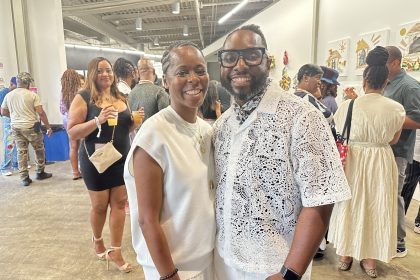
Twins are known to share many things. For identical twin sisters, Karen and Sharon Mackey, one of those mutual passions is visual art. In 2004 they founded the Mackey Twins Art Gallery in Mt. Vernon, New York. Since then, the gallery has come to house over 80 works of art by esteemed talents such as Xenobia Bailey, Leroy Campbell and Betty Blayton. Plus, the twins have received the National Conference of Artists Black History Makers Award, the WBLS Urban Community Award and in 2010, they were awarded the key to the city of Mt. Vernon.
At the center of their mission is supporting artists of color by not only providing an exhibition space, but also nurturing communities of art collectors. One of the first artists they collected is master artist James Denmark, whose work is in the Metropolitan Museum of Art. This past April they celebrated Denmark’s 80th birthday with a pop-up show of his work titled “The Legacy Continues: New Works, New Mediums.”
Recently, we chatted with the Mackey twins and Denmark about the state of collecting for artists of color.

A November 2015 New York Times article noted the “institutional neglect” Black artists have faced from museums. Now these institutions are putting in efforts to increase the amount of Black artists in their collections. What are your thoughts on these developments?
Sharon Mackey: When anything has been ignored and there is a movement to correct that the effort is still starting from a deficit. So while there is now an effort to push art by artists of color the pricing is not where it should be. The value placed on the art has to catch up as well.
Karen Mackey: Getting artists of color represented in galleries and museums is great. But we must also get collectors to feel a responsibility in supporting our artists. We have a responsibility and commitment to our own artists of color to put their works in our homes, corporations and hotels. Artists sometimes suffer because we don’t understand or feel that responsibility. It isn’t that we try to neglect our artists but sometimes we don’t grow up in that type of environment.
How does your gallery help instill within your visitors the mindset of being a collector?
KM: Before we started the business we felt uncomfortable in galleries. We weren’t very knowledgeable when looking at artwork and we didn’t like how we felt in some of these environments. So for us it’s about having a comfort level in our gallery. It is an environment where you gain knowledge and understanding of an artist. We created an environment that allows people to feel comfortable even if they don’t know something. That level of comfort transcends the economy so that people always want to come back regardless of their finances.
SM: It is a multifaceted issue. I find people tend to think art is out of their reach. Our role becomes about education to show how artists mark history. It is shifting responsibility and understanding that collecting art is intellectual property. There is no reason not to do it. It is an investment to buy what you love. The work never stops speaking to you.

Aside from creating the work to be collected, does the artist have a role to play or responsibility in nurturing collectors?
James Denmark: Indeed I do. My background as a teacher makes me feel that now it is still my duty to educate people as to who I am, what I do and what part art can play in their life. For people who don’t go down to large museums or galleries, they can feel the warmth and educational component provided in a place such as the Mackey Twins Art Gallery. It’s a setting where there is entertainment and no pressure. It’s about building community.













